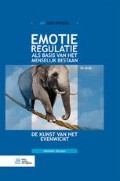Samenvatting
Hoe je moet omgaan met emoties leer je al vroeg, in de eerste relaties met anderen, zoals in de vorige hoofdstukken beschreven. En dan vooral in de relatie met ouders en verzorgers. Het is niet alleen nature, het is ook niet alleen nurture. Het is een interactie, een subtiele samenwerking tussen genen en omgeving. We betreden daarmee het terrein van de epigenetica.
Access this chapter
Tax calculation will be finalised at checkout
Purchases are for personal use only
Literatuur
Schore A. Affect regulation and the origin of the self. Mahwah (NJ): Erlbaum, 1994.
Lyons-Ruth K, Yellin C, Melnick S, Atwood G. Expanding the concept of unresolved mental states: hostile/helpless states of mind on the Adult Attachment Interview are associated with disrupted mother-infant communication and infant disorganization. Dev Psychopathol 2005;17:1-23.
Lyons-Ruth K, Yellin C, Melnick S, Atwood G. Childhood experiences of trauma and loss have different relations to maternal Unresolved and Hostile-Helpless states of mind on the aai. Attach Hum Dev 2003;5:330-52.
Lyons-Ruth K, Spielman E. Disorganized infant attachment strategies and helpless-fearful profiles of parenting: integrating attachment research with clinical intervention. Infant Ment Health J 2004;25:318-35.
Lyons-Ruth K, Dutra L, Schuder MR, Bianchi I. From infant attachment disorganization to adult dissociation: relational adaptations or traumatic experiences? Psychiatr Clin North Am 2006;29(1):63-86.
Ardizzi M, Martini M, et al. Impact of childhood maltreatment on the recognition of facial expressions of emotions. PLoS One 2015;10.
Den Hollander AM, Bruijn JA, Trijsburg RW. Alexithymie: fenomenologie, etiologie en therapeutische aspecten. Tijdschrift voor Psychiatrie 1991;33:577-91.
Kooiman CG. Alexithymia: Childhood factors and unexplained physical symptoms [dissertation]. Leiden: Rijksuniversiteit, 2003
Grubrich Simitis I. From concretism to metpahor: Thoughts on some theoretical and technical aspects of the psychoanalytical work with children of Holocaustsurvivors. The Psychoanalytic Study of the Child 1984;39:301-19.
Sacks O. A leg to stand on. London: Picador, 1984.
Ekman P. Gegrepen door emoties. Amsterdam: Nieuwezijds, 2003.
Van der Hart O, Nijenhuis ers, Steele K. Structural dissociation and the treatment of chronic traumatisation New York: Norton, 2006.
Rights and permissions
Copyright information
© 2018 Bohn Stafleu van Loghum, onderdeel van Springer Media B.V.
About this chapter
Cite this chapter
Nicolai, N.J. (2018). Ontregelde emoties: vervreemding. In: Emotieregulatie als basis van het menselijk bestaan. Bohn Stafleu van Loghum, Houten. https://doi.org/10.1007/978-90-368-2050-9_5
Download citation
DOI: https://doi.org/10.1007/978-90-368-2050-9_5
Publisher Name: Bohn Stafleu van Loghum, Houten
Print ISBN: 978-90-368-2049-3
Online ISBN: 978-90-368-2050-9
eBook Packages: Dutch language eBook collection

